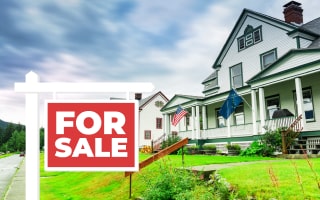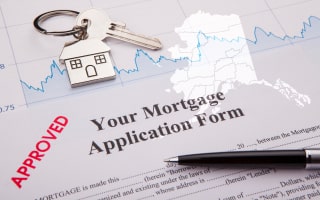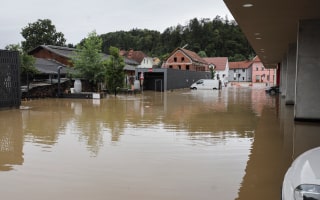Home Buying in Alaska

Sometimes known as The Last Frontier, Alaska is vast, with 570,641 square miles and 34,000 miles of shoreline. Its population of 733,000 people isn't evenly spread across those miles of land, but if it were, it would average fewer than 1.5 people per square mile. The population grows at less than 1 percent per year, and nearly half of all residents, about 261,000, live in Anchorage, while about 31,000 live in Juneau and Fairbanks each. Seven other large towns have populations of under 10,000.
Tourism, fishing, and oil extraction are the three largest industries in the state. Oil extraction alone is 85 percent of the state's economy, which supports a dividend of about $1,600 annually to every resident.
The housing market in Anchorage is short of available units. Property experts point to a decades-long stall in the construction of affordable units and a tightening of zoning regulations that made it harder to construct small, multi-unit buildings. In a 2018 report, a housing organization said the state needs to increase home construction by 90 percent to support the industries that need workers.
Despite its housing shortage, Anchorage is a buyer's market, perhaps because few people move there. Homes there average $373,000, an increase of over 6.5 percent in a year. In Juneau, the state capital, the median home sale was $492,700, an 18 percent increase in a year.
Buying a Home in Alaska
Most of the homes in Alaska's two largest cities were built in the early 1980s or before, making many of them outdated and in dire need of retrofitting for efficiency. The '80s was the era of the oil boom, when North Slope crude from Prudhoe Bay, 600 miles north of Anchorage, was being pumped at 1.5 million barrels a day. The peak year was 1989.
Given the state's potential for extreme weather and temperatures, insulation, and heating efficiency are key factors in making life affordable in Alaska. A survey of Juneau homes found that upgrades are necessary as homes in that city and across the state used an average of 220 million BTUs of energy per year, 1.9 times the national average. Another study revealed people in rural Alaska pay 260 times more than other states for energy costs for their water systems.
Despite the anecdotal evidence, a major news magazine ranked Alaska's quality of life 45th among all states, yet 35th in affordability, ahead of Arizona. The state was 3rd in the economic opportunity category and received high scores for economic stability.
The median individual income in Alaska is $82,000 per year; a household of two can expect to earn $98,000. One source says renting is the more cost-effective option if you can find a suitable place for the average $1,700 monthly fee. Paying a mortgage on a home is likely to cost $2,000 per month, or $24,000 per year, just barely affordable for someone making the average wage in Alaska. Most mortgage companies won't allow a borrower's monthly payments to add up to over one-third of their annual income.
The average home in Anchorage sells within three weeks of listing. Being prequalified for a mortgage is key so you can move quickly when you find the right place. Have your 10- to 20-percent down payment ready, and be prepared to act fast. In order to get a mortgage, you need a solid work history and a credit score above 600. (It can be a bit lower if you can make a 20 percent down payment.) Paying off loans and making prompt payments on debts improves your credit score, which is based in almost equal parts on your payment history and your income-to-debt ratio.
Finding the Right Home

Alaskan homes can have some unique features not found elsewhere. Here, there are many heated garages because the winter cold can kill a car's battery quickly. Other properties may be handmade, one-of-a-kind places, or even raised off the ground to account for the amount of snow an area gets. Even in established towns, there are homes with drive-in snowmobile sheds and auxiliary power systems. More unusual, yet not wholly unexpected, are the properties with airplane hangars or airstrips for a small private bush plane – some planned communities have a shared airstrip.
Extraordinary expenses related to living in Alaska are a key consideration, including heating, electrical, fuel, shipping costs for necessities, etc. According to one vlogger from a community north of Anchorage, many residents pay an average of their utilities over time so the bills for electricity and heat are not sky-high during winter. Those with city water and sewer service may pay higher rates outright, but those who have a well pay extra for the electric pump that delivers the water from the ground to the faucet. Some residents even pay more for a bear-proof trash can.
Other sources say the cost of healthcare in Alaska is 70-200 percent higher than elsewhere in the country.
Following destructive earthquakes in 1964 and again in 2018, Alaska lawmakers are advocating for a statewide building code that incorporates designs to better withstand seismic events. Studies point to newer, more earthquake-resilient designs in certain areas of Anchorage that had less damage from the 2018 event. The report says wood construction that did not include earthquake-mitigating design performed poorly compared to buildings with structural steel. It's unclear if an earthquake-resistant home would command a higher price.
The state does not have income or sales tax, but property taxes are high due in part to high property values. Juneau's property taxes have been reduced somewhat in the past few years, so residents pay an average of $10.16 per $1,000 of assessed value, down from $10.28. The assessed value of a property is usually 20 percent of the fair market value. In Anchorage, the average mill rate is 17.69, which is $17.69 per $1,000 of assessed value. Personal property is also taxed in Alaska. That includes things like vehicles, airplanes, and boats.
When considering homes to buy in Alaska, expenses, property prices, and taxes may narrow options. The proximity to jobs, school, or other necessities is crucial.
In rural Alaska, things to think about include the following:
-
Access to healthcare and emergency services
-
Travel time to work and necessities
-
Earthquake or flood insurance
-
Comfort level with self-reliance
In urban areas, considerations include:
-
High property taxes
-
Home Insurance
-
Age and condition of the property
-
Cost of utilities
What is the Typical Home Buying Process in Alaska
Homes in Alaska are likely to sell quickly if they are newer and well-constructed. Unique homes in the bush are harder to sell as the pool of people likely to be self-reliant and prepared for the lifestyle is smaller. In any case, you should be prequalified for a mortgage, have a significant down payment ready, and be prepared to negotiate a higher bidding price if you are determined to purchase a specific property.
Some people feel that having the counsel and guidance of a local realtor called a buyer's agent, enhances their chances of finding an appropriate home. This realtor works on your behalf by sifting through listings to find those that most closely match your desired location and amenities. They also help you create a strategy for finding and purchasing a home, including writing your offer and negotiating the price.
Your realtor should have research ready on the price history of a home and the pros and cons of the local area, as well as provide information on state and local property taxes. In addition to helping with the initial offer, they will help hire an inspector, renegotiate the price if there are structural or systemic issues, and keep the closing process on track.
Buyer's agents now require a contract that discloses their role and payment. Instead of splitting a 5-6 percent commission with the seller's agent, they negotiate their own. The commission can be written into the purchase offer, making it part of the sale price.
In general, the process of buying a home is:
-
Prequalifying for a mortgage.
-
Researching the best area to buy, and ranking alternatives.
-
Making an offer.
-
Making a down payment.
-
Getting the property inspected.
-
Having the deed researched.
-
Closing the deal, including paying closing costs.
Financing Your Home Purchase

Know your budget by prequalifying for a mortgage. The median income in Anchorage is $98,000 for a household or $82,000 per individual. A single buyer making $82,000 with 10 percent down on a $400,000 home ($360,000 mortgage) is unlikely to be approved for a 30-year mortgage because payments would be about $2,500 per month. Lenders won't allow most buyers to take on a mortgage that's more than one-third of their annual income. Closing costs are usually an additional $4,000-$6,500.
Start with your local bank when shopping for the best mortgage. Your local bank may extend special benefits to regular customers to get their mortgage business. Elsewhere, a mortgage broker has access to a wide variety of mortgage choices and can find a good deal for you. Your decision may hinge on your knowledge of and comfort level with the mortgage industry.
Your income-to-debt ratio and history of on-time payments are critical to qualifying for good mortgage terms. Your credit should be above 600 for government-backed loans and above 640 for other mortgages. Start early by requesting free copies of your credit report from the major agencies (Experian, Equifax, and TransUnion) to correct any errors.
The federal interest rate sets the tone for individual mortgages, and right now, it's above 7 percent, the highest in years. This translates to higher payments for buyers.
Fixed-rate mortgages are great if interest rates are low but less desirable if rates are high (rates rise and fall incrementally over periods of years). Adjustable-rate mortgages are riskier because the interest rate can change during the loan's term. Jumbo mortgages allow wealthy buyers to borrow more than the federal housing authority limit, about $766,000, in areas of particularly high property values.
Mortgage options include these government programs:
- Alaska offers special loans for first-time, disabled, and veterans through the Alaska Housing Finance Corporation.
- FHA mortgages are tailored for first-time buyers with down payments of less than 5 percent.
- Rural properties may qualify for USDA loans, especially buyers with low incomes but good credit scores.
- Military veterans and their surviving spouses may seek a Veterans Administration-underwritten VA loan. These mortgages do not require PMI and may be used multiple times by qualifying individuals.
Home Insurance

It’s expensive to insure your home against loss, including severe weather events like those occasionally experienced in Alaska. The national average cost of homeowner’s insurance is $1,800 per year, but in Alaska, it can be as low as $1,300. Your mortgage lender may require homeowner’s insurance and mortgage insurance, called PMI, to protect their interest in the property. In Alaska, property insurance is not required for homeowners.
Lenders require PMI, or mortgage insurance when a buyer puts down less than a 20 percent down payment. The cost of PMI varies according to credit score but is generally between $400 and $1,400 per month in addition to the mortgage payment.
Barns, fences, and garages must be specifically noted in the policy for coverage. Valuable personal possessions inside the home are unlikely to be covered by insurance unless an additional rider is written.
Home Buying Challenges
Scammers may try to trick prospective property buyers into putting money down on vacant or seasonal homes. Alaska police have issued a caution to buyers to carefully check the documents associated with an "owner" trying to sell. If a down payment is made on a property that does not belong to the person who says they are selling, it is almost impossible to get the money back.
If fixer-upper homes seem preferable to paying high market prices, keep in mind that contractors and tradesmen are in short supply everywhere, the building season can be short in Alaska, and the cost of construction materials, insurance, and fuel are all higher in the 49th state.
Alaska Home Inspections
Alaska is known for its cold and stormy weather. It routinely experiences heavy snow, record-breaking cold temperatures, high winds, and heavy rainfall, often leading to floods. Alaska's climate is rough on property and can cause various types of damage over time. To avoid wasting money, real estate buyers must insist on an Alaska home inspection before purchasing. The home inspection can reveal any severe damage or costly issues. It could also give the buyer some negotiating power if anything is found.
A home inspection in Alaska covers many items, including those below. It aims to ensure the structural integrity and functionality of major systems and appliances and assess the home's safety features.
-
Structure: Foundation, walls, columns, chimney, crawlspaces.
-
Attic: Framing, sheathing, insulation, ventilation, electricity, HVAC, and ductwork.
-
Roof: Shingles, flashing, skylights, and gutters.
-
Garage: Doors, door opener, fire separation, walls/ceiling, slab, cabinets.
-
Plumbing: Supply line, main valve, pumps, water heaters, and fixtures (toilets, sinks, tubs, faucets, showers).
-
HVAC: Heating and cooling systems, ductwork, ventilation.
-
Electric: Panels, circuit breakers, outlets, and fault breakers.
-
Interior: Walls, floors, doors, windows, doorbell, closets, ceilings.
-
Safety: Smoke detectors, carbon monoxide alarms, and fire sprinklers.
-
Grounds: Walkways, grading, drainage, driveway, and other property areas.
An Alakas home inspection costs between $300 and $500, depending on the home's age, size, and condition. The complexity of the inspection may also factor into the price.
The Process
Buyers often pay for a home inspection in Alaska because it benefits them the most. Rarely, a seller may opt for a pre-listing inspection to ensure a smooth sale. The process looks as follows:
- Find and hire a reputable home inspection firm.
- Schedule the inspection according to your purchase contract.
- Show up and stay for the entire inspection; ask questions as needed. The inspection will last two to four hours.
- Review the inspection report and decide what to do next.
The top five home inspection companies in Alaska are:
- AK Home Inspection Services LLC - Anchorage, AK
- Discovery Inspection Services - Anchorage, AK
- The Home Inspector Alaska, LLC - Palmer, AK
- Alaska Home Detectives - Wasilla, AK
- 907 Home Inspections, LLC - Palmer, AK
After the Inspection
After the inspection, the inspector sends all relevant parties a copy of the final report. The buyer then has some options on how to proceed. If the report shows serious issues that should be resolved, the buyer can:
- Try to save some money by negotiating a better price.
- Ask the seller to make all the necessary repairs before closing.
- They can back out of the sale and walk away without losing any money.
- Ask for a home warranty or lower down payment.
Inspection Top Cities
| City | Inspection Cost | Local Issues | Local Rules | Local Home Types |
|---|---|---|---|---|
| Home Inspection in Sitka | $300-$500 depending on the home's size and age. | Structural issues, water damage, and mold. | Governed by the Alaska Department of Commerce, Community, and Economic Development. Inspectors must supply the buyer with a written report. | Apartments, condos, houses, cottages, cabins, and duplexes. |
| Home Inspection in Wrangell | $300-$500 based on the size, age, and features of the house. | Roof damage (due to snow and ice), plumbing problems (burst pipes), and mold. | Inspectors must pass an exam. | Single-family homes, apartments, and condos. |
| Home Inspection in Juneau | $300-$500 based on the home's size, age, and condition. | Roof, drainage, structural, plumbing, termites, and water damage. | Not mandated. | Single-family, condos, townhomes, and multi-family properties. |
| Home Inspection in Anchorage | $300-$500 based on the size and age of the home. | Roof, electricity, water damage, plumbing, foundation, and poor ventilation. | Inspectors must be licensed and registered with the Alaska Department of Commerce, Community, and Economic Development. | Single-family, townhomes, condos, and multi-family properties. |
| Home Inspection in Healy | $350-$500. Larger and older homes cost more. | Roof, poor insulation, electrical, and poor drainage. | No local rules. | Single-family, condos, and townhouses. |
Instant Access to Alaska Property Records
- Owner(s)
- Deed Records
- Loans & Liens
- Values
- Taxes
- Building Permits
- Purchase History
- Property Details
- And More!